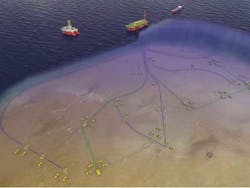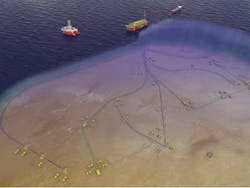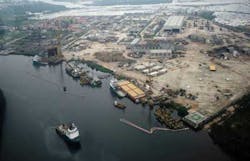Nigerian yards tackle wide-ranging subsea spread for deepwater Egina development
Jeremy Beckman
Editor, Europe
NNPC and OML 130 license operator Total Upstream Nigeria Ltd., in association with partners Sapetro, Petrobras and CNOOC, have initiated the Egina project, their third major deepwater development offshore Nigeria since mid-2005. The field was discovered in 2003 in the OML 130 block in 1,750 m (5,741 ft) of water, 20 km (12.4 mi) southwest of the Akpo field complex in the same license. Development calls for 44 subsea wells connected to a 330-m (1,082-ft) long FPSO with an oil storage capacity of 2.3 MMbbl. Total is aiming for start-up at the end of 2017, building to plateau production of 200,000 b/d.
Among the major awards issued soon after the project's announcement in late June was Saipem's $3-billion contract for Egina's subsea facilities. This involves engineering, procurement, fabrication, installation, and pre-commissioning of 52 km (32 mi) of oil production and water injection flowlines; 12 flexible jumpers; 2 km (1.2 mi) of oil export line; 20 km of gas export pipelines; along with installation and commissioning of 80 km (49.7 mi) of steel tube umbilicals and the mooring of the FPSO and the offshore oil loading terminal (OLT) buoy. Most of the fabrication will be performed in Nigeria, with marine installations to follow during 2016 and the early part of 2017.
Offshore spoke to Guido d'Aloisio, Saipem's project director for the Egina UFR (umbilicals, flowlines, risers) project, which is the largest in the company's history.
Offshore: Why is the value of this contract so high?
D'Aloisio: This is mainly due to the wide-ranging scope and the long offshore installation campaign. The price also takes into account inflation in Nigeria, where costs of construction, materials, and labor are growing year on year.
Offshore: How long has Saipem operated a manufacturing and engineering base in Nigeria?
D'Aloisio: The Saipem group has been present in Nigeria for more than 45 years. Saipem Contracting Nigeria Ltd. (SCNL)'s Rumuolumeni yard in Port Harcourt was established in 1999. It grew over the years to reach today's total area of 700,000 sq m (7.5 million sq ft), of which 30,000 sq m (322,917 sq ft) are covered. We implemented an extensive upgrading program for the Usan project to turn the asset into an international-class fabrication yard and logistics base, with state-of-the-art facilities, including new cranes. This is for sure the most extensive yard in West Africa in terms of acreage and equipment, with an increased fabrication capacity of 22,000 tons/yr, sufficient to handle the Egina UFR project requirements.
Offshore: Can you outline Saipem's involvement in Total's previous deepwater projects offshore Nigeria?
D'Aloisio: In May 2005, Saipem was awarded the EPCI contract for Total Upstream Nigeria's Akpo UFR field development in 1,350 m (4,429 ft) water depth, around 200 km (124 mi) south of Port Harcourt. Our scope comprised engineering, procurement, construction, installation, and commissioning of the umbilicals, flowlines, and risers; the offshore oil loading terminal; the FPSO mooring system; and the gas export pipeline from Akpo to the shallow-water Amenam AMP2 platform. Under this contract Nigerian companies provided 1.5 million man hours of work, and the onshore fabrication work was performed mainly by the SCNL Rumuolumeni yard.
Just under three years later, Elf Petroleum Nigeria (Total) awarded a consortium led by Saipem the UFR and OLT contract for the Usan Deep Water development in 730-850 m (2,395-2,789 ft) water depth, some 160 km (99.4 mi) south of Port Harcourt. Here our scope included engineering, procurement, construction, installation, pre-commissioning, assistance for commissioning, and start-up of 72 km (44.7 mi) of subsea umbilicals, 61 km (38 mi) of flowlines and risers connecting the 42 subsea wells to the FPSO. We were also responsible for the OLT, comprising an offloading buoy and two offloading lines, in addition to part of the FPSO anchoring system.
More recently, Saipem has also been awarded the OFON2-D030 contract by Total E&P Nigeria Ltd. for new offshore facilities for the Ofon field, about 50 km (31 mi) off the southern coast of Nigeria.
Saipem's scope of work includes the engineering, procurement, fabrication, and installation of the OFP2 jacket (comprising the 1,970 ton jacket structures and the 4,500-ton piles), as well as the transportation and installation of the complete new OFQ living quarter offshore platform.
The fabrication of the jacket was performed in the Saipem Rumuolumeni yard in Port Harcourt, Nigeria, with offshore activities performed mainly by theSaipem 7000 vessel, from early November until mid-December 2013.
Offshore: Will the Port Harcourt yard manufacture most of the items in Saipem's contract for Egina?
D'Aloisio: Because of the company's strong commitment to local content, the vast majority of fabrication works for the Egina UFR project will be performed at the yard. Besides this, one of the main goals of the entire project is to prioritize the use of indigenous suppliers and vendors. As part of our ongoing program to develop local capabilities, Saipem is also auditing and qualifying major Nigerian subcontractors to assess the scope of work that they can perform.
One is Energy Works Technology Ltd. (EWT) in Port Harcourt, which will manufacture suction piles for the oil offloading buoy and pig launchers/receivers. We are following closely upgrades of their yard so that they can execute this work. Another designated subcontractor is PCNL Tenaris, formerly Socotherm's coating yard and now managed by Tenaris which owns part of the company. They are undergoing qualification for 5LPP insulation coating of the linepipes and we expect to award this contract upon successful results of these qualifications.
The entire Egina UFR project is run from Saipem Contracting Nigeria's premises in Lagos, and most of the engineering is being performed in Nigeria, either in-house by Saipem or by DeltaAfrik Engineering Ltd. We have worked with this company on previous projects. As part of our strategy of building local capacity and transferring know-how we have also run an extensive training program for 60 local engineers to develop the multi-disciplinary expertise required for the development of deepwater projects. It covered areas such as cathodic protection, geotechnical, subsea structures, flowlines, risers, and installation engineering. Training started initially here in Lagos, conducted by Saipem experts. We then sent the trainees to our deepwater competence center in Paris where they remained for a minimum duration of three months. After their return, their training continued on the job, and some are now recognized as leaders in their field in Nigeria.
Offshore: Turning to the offshore installations, are there any novel aspects of the subsea architecture?
D'Aloisio: Egina UFR presents numerous technical challenges, mainly due to the water depth. Chief among these are the qualification and installation of the 20.5-in. flexible oil offloading lines, which are the largest anywhere; the organization of the riser layout, comprising eight top-tensioned risers between production, gas export and water injection types in a very compact area; and the resolution of the high fatigue loads induced by slugging effect, in particular to the riser base spools.
The 1,250-m (4,101-ft) long, steel single hybrid risers (SHRs) will be fully rigid up to the jumper connections to the FPSO. They will be of the same proprietary design that we applied for Usan. Compared to steel catenary risers (SCRs), the SHRs present numerous advantages. Their configuration means that they are virtually fatigue-free, with no particular requirement to counter weld fatigue. Additionally, they can be installed prior to or after arrival of the FPSO to the benefit of the field installation schedule. In addition SHRs have the advantage of minimizing the loads on the FPSO hull, freeing payloads for modules and equipment.
As for the high slugging fatigue loading, we will develop a suitable spool design, including welds that have to be specifically qualified to combat fatigue in sour environment.
Saipem will address all these issues by drawing on its experience, technology methodologies from previous deepwater projects, and the solutions should make this a benchmark for future deepwater UFR developments.
Offshore: Are any problems foreseen with production from certain parts of the field, and how is the subsea production system engineered to prevent hydrates formation following a shutdown?
D'Aloisio:The production system will be based on wet insulation technology which can be considered mature and already field proven for the same water depth range (e.g. Akpo). The thermal performance (cool down time and overall heat transfer co-efficient) of the production system will be subject to an in-field performance guarantee test. Results of thermal performance tests in our previous UFR projects have always proved that the installed equipment was performing well within client targets. In addition, hydrate prevention and remediation strategies such as methanol injection and coiled tubing intervention could be applied.
Offshore: Has Saipem assigned vessels for the marine installations planned for 2016-17?
D'Aloisio: We will mobilize very specific deepwater construction and deepwater pipelay vessels from our fleet. These will be supported by numerous logistics vessels and barges, with assistance from Saipem Contracting Nigeria's base in Port Harcourt.
Offshore: Do you foresee any technical issues with the installations because of local offshore conditions?
D'Aloisio: Every effort is made at each stage of a project to minimize weather condition dependence on installation activities. Sensitivity to weather is a key input during the design phase, ensuring that each item will be installed in the safest and most efficient manner. During the installation phase, weather vaning and resonance prevention are efficient measures typically implemented to minimize weather impact.
However, the main technical challenge will be the installation of the risers, which will have to be top-tensioned by huge buoyancy tanks of 6-7 m (19.7-23 ft) diameter, and up to 50 m (164 ft) long. These will be filled with nitrogen to allow dewatering and to sustain the water depth. The buoyancy tanks will be bigger than those deployed for the Usan risers, and the potential impact on the installation vessel, combined with weather, requires a very detailed assessment.
It is also worth noting that the particular architecture of the field layout, notably the close distance between consecutive water injection drill centers, requires the use of high performance pipelay vessels because of the need to control heavy flowlines catenaries with multiple in line structures. The expected dimensions of the spools also requires top-tier heavy construction vessels.






